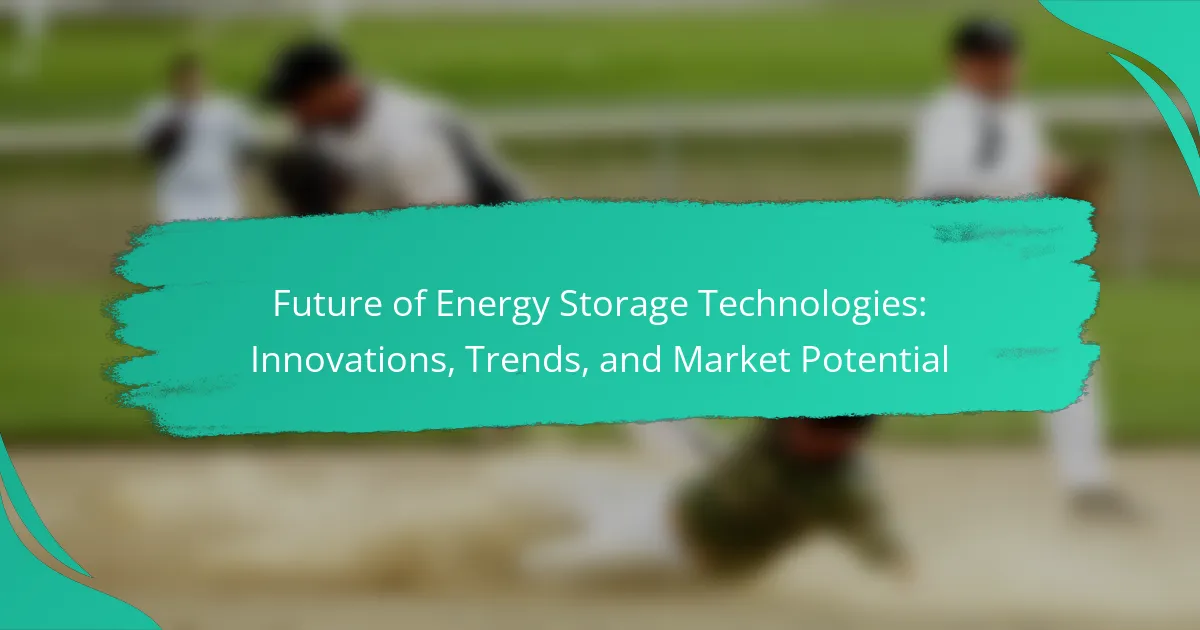The future of energy storage technologies is poised for transformative growth, driven by innovations that enhance efficiency, capacity, and safety while lowering costs. As the demand for sustainable energy solutions escalates, advancements in battery chemistry and grid integration are reshaping how energy is stored and utilized, offering significant benefits such as improved grid reliability and increased adoption of renewable sources.
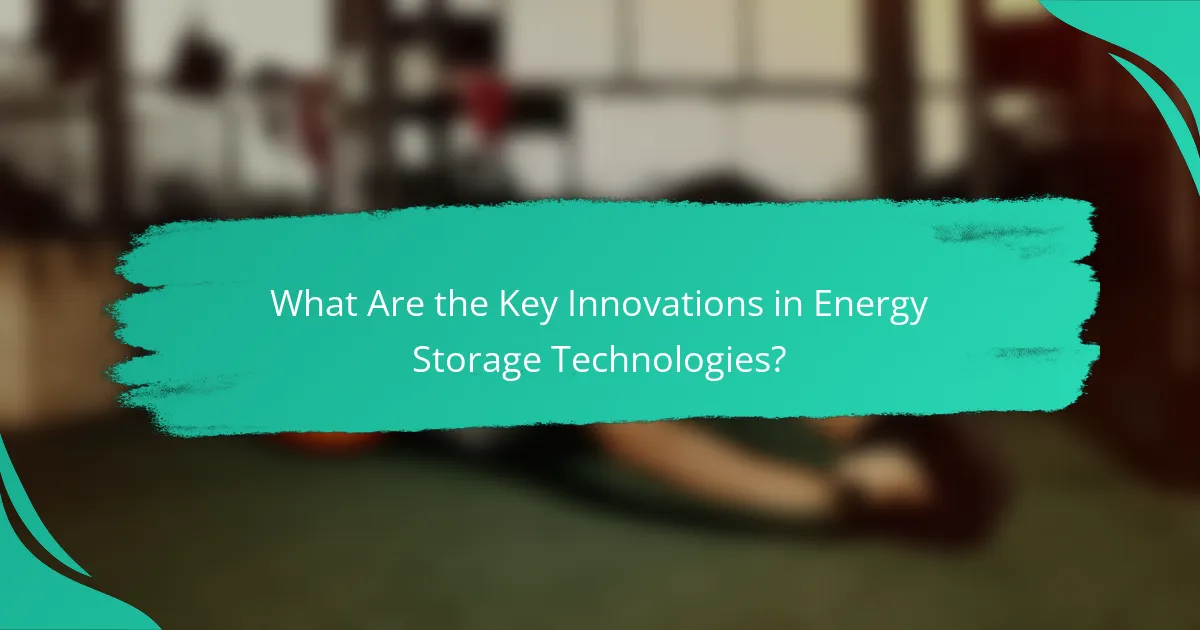
What Are the Key Innovations in Energy Storage Technologies?
Key innovations in energy storage technologies focus on improving efficiency, capacity, and safety while reducing costs. These advancements are crucial for integrating renewable energy sources and enhancing grid stability.
Solid-state batteries
Solid-state batteries utilize a solid electrolyte instead of a liquid one, which enhances safety and energy density. They can potentially offer higher capacities and faster charging times compared to traditional lithium-ion batteries.
These batteries are still in the development phase, with commercial applications expected in the coming years. Manufacturers are exploring various materials to optimize performance and reduce production costs.
Flow batteries
Flow batteries store energy in liquid electrolytes contained in external tanks, allowing for scalable energy storage solutions. They are particularly suitable for large-scale applications, such as grid energy storage, due to their long cycle life and ability to discharge for extended periods.
Common types include vanadium redox and zinc-bromine flow batteries. Their modular design enables easy expansion, making them a flexible option for energy storage needs.
Compressed air energy storage
Compressed air energy storage (CAES) systems store energy by compressing air in underground caverns or tanks. When energy is needed, the compressed air is released to drive turbines and generate electricity.
CAES can provide large-scale energy storage, making it suitable for balancing supply and demand in power grids. However, efficiency can be a concern, often requiring additional energy input for compression and heating.
Hydrogen storage systems
Hydrogen storage systems generate and store hydrogen gas, which can be used as a clean fuel source or converted back into electricity. This technology is gaining traction as a means to store excess renewable energy.
Hydrogen can be stored in various forms, including compressed gas, liquid, or chemical compounds. Each method has its own advantages and challenges, particularly regarding energy density and infrastructure requirements.
Advanced lithium-ion technologies
Advanced lithium-ion technologies focus on improving the performance and lifespan of traditional lithium-ion batteries. Innovations include using new materials for electrodes and electrolytes to enhance energy density and reduce costs.
Examples include silicon-based anodes and solid electrolytes, which can significantly increase battery capacity. These advancements are critical for electric vehicles and portable electronics, driving the demand for more efficient energy storage solutions.
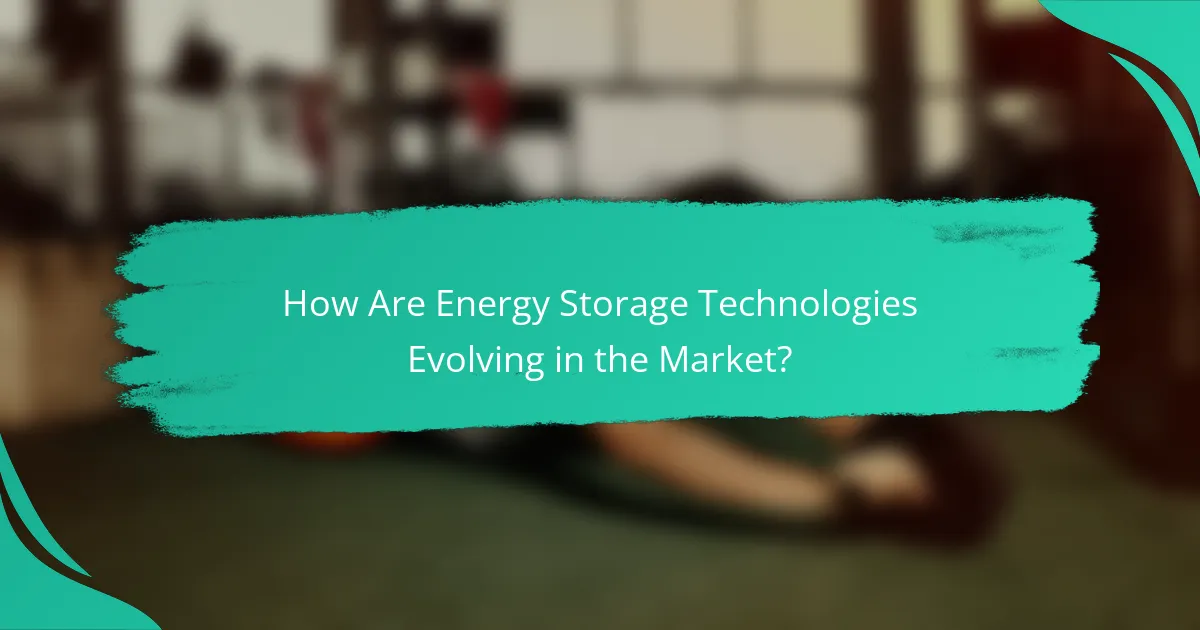
How Are Energy Storage Technologies Evolving in the Market?
Energy storage technologies are rapidly evolving to meet the increasing demand for efficient and sustainable energy solutions. Innovations in battery chemistry, grid integration, and cost reduction are driving significant changes in how energy is stored and utilized across various sectors.
Increased adoption of renewable energy
The rise of renewable energy sources, such as solar and wind, is a key driver for advancements in energy storage technologies. As these sources are intermittent, effective storage solutions are essential to balance supply and demand. Technologies like lithium-ion batteries and flow batteries are becoming more common in residential and commercial applications to store excess energy generated during peak production times.
For instance, homeowners can now install battery systems that store solar energy for use during the night or cloudy days, enhancing energy independence and reducing reliance on the grid.
Government incentives and regulations
Government policies play a crucial role in the evolution of energy storage technologies. Many countries offer incentives, such as tax credits or rebates, to encourage the adoption of energy storage systems. Regulations promoting renewable energy integration into the grid further stimulate market growth.
In the United States, programs like the Investment Tax Credit (ITC) provide financial support for solar and storage projects, making them more accessible to consumers and businesses alike. Similar initiatives exist in Europe, where the EU aims to increase energy storage capacity as part of its Green Deal.
Investment trends in energy storage
Investment in energy storage technologies is witnessing significant growth as stakeholders recognize their potential. Venture capital, private equity, and government funding are increasingly directed toward innovative storage solutions, including advanced battery technologies and grid-scale systems.
Recent trends indicate that investments are not only focused on traditional battery technologies but also on emerging solutions like solid-state batteries and hydrogen storage. These innovations promise higher efficiency and longer lifespans, which could reshape the energy landscape in the coming years.
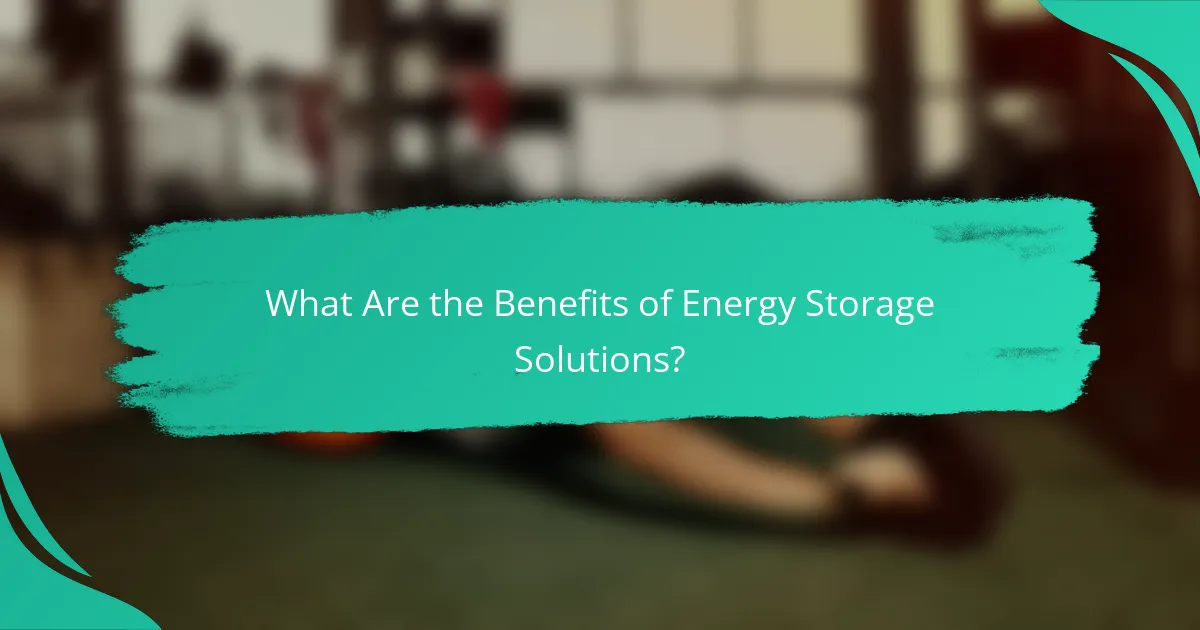
What Are the Benefits of Energy Storage Solutions?
Energy storage solutions offer numerous advantages, including improved grid reliability, cost savings for consumers, and enhanced utilization of renewable energy sources. These benefits contribute to a more resilient and efficient energy system.
Grid stability and reliability
Energy storage systems help maintain grid stability by balancing supply and demand in real-time. They can store excess energy during low demand periods and release it during peak times, reducing the risk of blackouts and ensuring a steady power supply.
For instance, battery storage can respond to grid fluctuations within seconds, making it a crucial component for integrating variable renewable energy sources like solar and wind. This rapid response capability enhances overall grid reliability.
Cost savings for consumers
Consumers can benefit from energy storage solutions through reduced electricity bills. By storing energy during off-peak hours when prices are lower and using it during peak hours when prices are higher, households can significantly lower their energy costs.
In some regions, incentives and rebates for energy storage installations can further enhance savings, making these systems more accessible. Additionally, energy storage can help avoid costly infrastructure upgrades by alleviating peak demand on the grid.
Enhanced renewable energy utilization
Energy storage technologies facilitate greater use of renewable energy by addressing its intermittent nature. By storing excess energy generated during sunny or windy conditions, these systems ensure that renewable sources can provide a consistent energy supply even when production dips.
For example, solar energy can be stored during the day and used at night, maximizing the efficiency of solar installations. This capability not only supports sustainability goals but also helps reduce reliance on fossil fuels, contributing to a cleaner energy future.
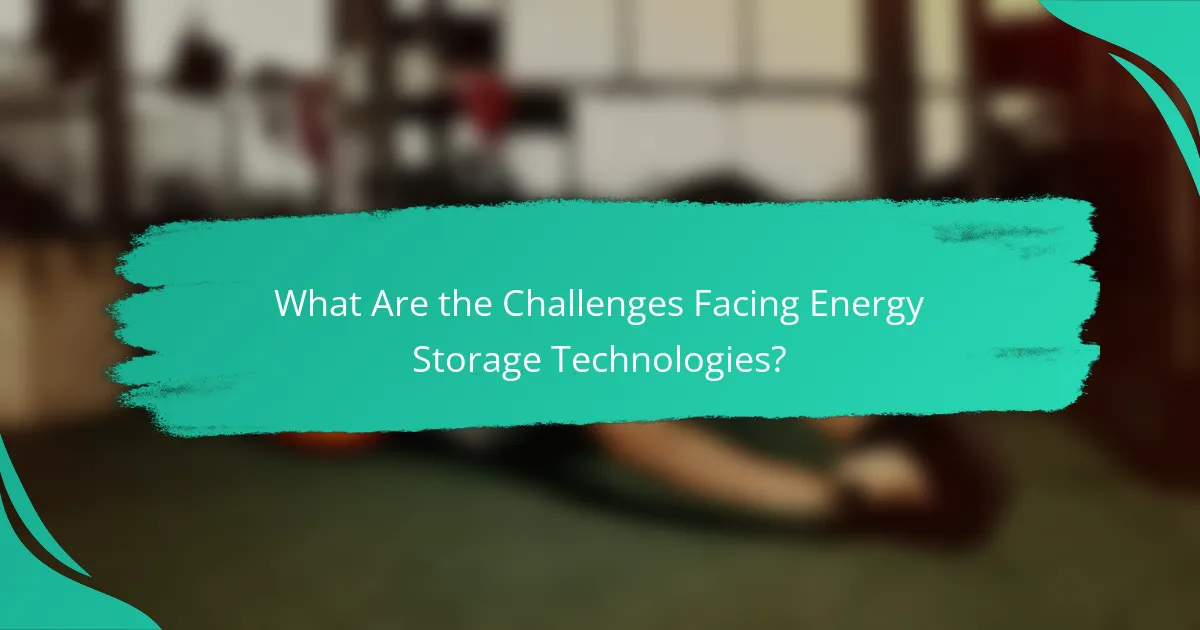
What Are the Challenges Facing Energy Storage Technologies?
Energy storage technologies face several significant challenges that hinder their widespread adoption and efficiency. Key issues include high initial costs, limited lifespans of certain technologies, and regulatory hurdles that complicate implementation.
High initial costs
The high initial costs of energy storage systems can be a major barrier to entry for many users, including homeowners and businesses. For example, lithium-ion battery systems can range from several thousand to tens of thousands of dollars, depending on capacity and installation requirements.
Investing in energy storage often requires careful financial planning. Users should consider potential long-term savings on energy bills and incentives available in their region, such as tax credits or rebates, which can help offset these upfront expenses.
Limited lifespan of certain technologies
Many energy storage technologies have a limited lifespan, which can affect their overall cost-effectiveness. For instance, lead-acid batteries typically last around 3 to 5 years, while lithium-ion batteries may last 10 to 15 years, depending on usage and maintenance.
When selecting a storage solution, users should evaluate the expected lifespan and performance degradation over time. Understanding the cycle life and warranty terms can help in making informed decisions about which technology to invest in.
Regulatory hurdles
Regulatory hurdles can significantly impact the deployment of energy storage technologies. Different regions have varying regulations regarding grid interconnection, safety standards, and financial incentives, which can create confusion and delays in project implementation.
To navigate these challenges, stakeholders should engage with local authorities and industry groups to understand the regulatory landscape. Staying informed about changes in legislation and potential funding opportunities can facilitate smoother project execution.
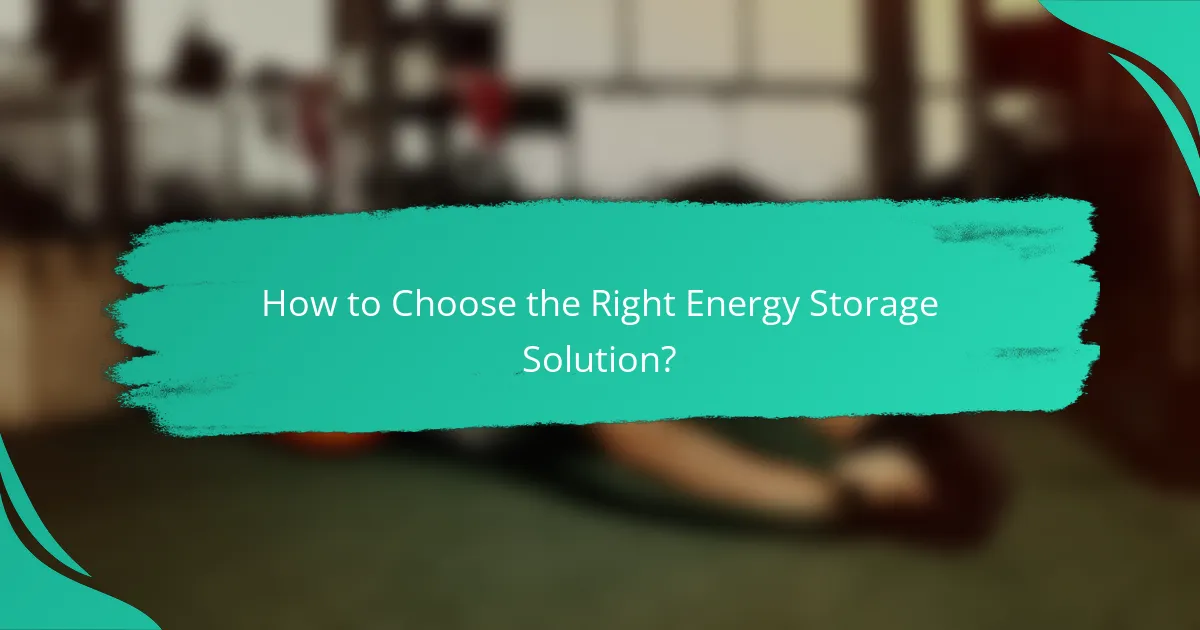
How to Choose the Right Energy Storage Solution?
Choosing the right energy storage solution involves evaluating your specific energy needs, budget, and the technology available. Consider factors such as capacity, discharge rates, and the intended application to make an informed decision.
Assessing energy needs
Assessing energy needs is the first step in selecting an appropriate energy storage solution. Determine the amount of energy you require based on your usage patterns, peak demand, and the duration for which you need the stored energy. This can vary significantly between residential, commercial, and industrial applications.
For residential users, consider daily energy consumption and peak usage times. A typical household may need a storage capacity ranging from 5 kWh to 15 kWh, depending on the number of appliances and their usage. For commercial setups, analyze the load profile to identify peak demand periods and total energy requirements over a day or week.
It’s also essential to factor in future energy needs, such as potential expansions or increased usage. This foresight can help avoid the pitfalls of under-sizing or over-sizing your energy storage system, which can lead to inefficiencies and higher costs.
